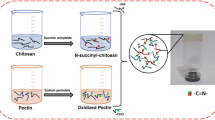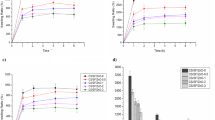Abstract
Biological hydrogel is important in drug delivery system and tissue engineering. In this paper, we prepared a series of biological hydrogels with N, O-carboxymethyl chitosan (CS) and oxidized safflower and ligusticum wallichii polysaccharide-II (oxidized SLWP-II). Morphological analysis indicated the N, O-carboxymethyl CS/oxidized SLWP-II hydrogels (CSLHs) had porous interior structures, pore diameter ranged from tens to hundreds of micrometers. In vitro release test showed, with proportion of N, O-carboxymethyl CS to oxidized SLWP increasing from 1:1 to 1:3, cumulative release of bovine serum albumin decreased from 99 to 82%. In vitro cytotoxicity study showed that the developed hydrogels were not cytotoxic during one week of culturing with WI-38 cells, and they have a role in promoting cell proliferation. So the N, O-carboxymethyl CS/oxidized safflower and ligusticum wallichii polysaccharide-II hydrogels might have potential application in the drug delivery system and tissue engineering.








Similar content being viewed by others
References
E. Khor: Chitin: A biomaterial in waiting. Curr. Opin. Solid State Mater. Sci. 4, 313–317 (2002).
N.A. Peppas, Y. Huang, and M. Torreslugo: Physicochemical foundations and structural design of hydrogels in medicine and biology. Annu. Rev. Biomed. Eng. 2, 9–29 (2000).
M.S. Shoichet: Polymer scaffolds for biomaterials applications. Macromolecules 43, 581–589 (2010).
M. Rinaudo: Main properties and current applications of some polysaccharides as biomaterials. Polym. Int. 57, 397–430 (2008).
L.C. Alvarez, F.B. Blanco, A.M. Puga, and A. Concheiro: Crosslinked ionic polysaccharides for stimulisensitive drug delivery. Adv. Drug Delivery Rev. 65, 1148–1171 (2013).
L. Chen, C. Tang, N. Ning, C. Wang, and Q. Zhang: Preparation and properties of chitosan/lignin composite films. J. Polym. Sci. 27, 739–746 (2009).
H. Honarkar and M. Barikani: Applications of biopolymers I: Chitosan. Monatsh. Chem. 140, 1403–1420 (2009).
C.M. Yeng, H. Salmah, and S.T. Sam: Modified corn cob filled chitosan biocomposite films. Polym.-Plast. Technol. Eng. 52, 1496–1502 (2013).
M.A. Aziz, J.D. Cabral, and S.C. Moratti: Antimicrobial properties of a chitosan dextranbased hydrogel for surgical use. Antimicrob. Agents Chemother. 1, 280–287 (2012).
L. Yin, X. Zhao, and J. Ding: Cytotoxicity and genotoxicity of superporous hydrogel containing interpenetrating polymer networks. Food Chem. Toxicol. 6, 1139–1145 (2009).
S.H. Lim and S.M. Hudson: Synthesis and antimicrobial activity of a water-soluble chitosan derivative with a fiber-reactive group. Carbohydr. Res. 339, 313–319 (2004).
G. Ma, D. Yang, Y. Zhou, M. Xiao, J.F. Kennedy, and J. Nie: Preparation and characterization of soluble-alkylated chitosan. Carbohydr. Polym. 74, 121–126 (2008).
J.S. Fu and Q.R. Sun: Preparation of the high degree of substitution of carboxymethyl chitosan and handictaft research. Pet. Chem. Ind. Prog. 12, 56–58 (2010).
J.D. Wang, W. Liu, R.L. Yang, and X.B. Sun: Effects of ligusticum chuanxiong polysaccharides on proliferation and apoptosis of human hepatoma cell line HepG2. J. Nanjing Univ. Tradit. Chin. Med. 30, 461–464 (2014).
X.K. Shi, D.Q. Ruan, Y.X. Wang, L. Ma, and M.Q. Li: Antitumor activity of safflower polysaccharide and its effects on CTL and NK cell killing activity in T739 lung cancer mice. Chinese J. Tradi. Chinese Medi. 35, 215–218 (2010).
Z.C. Fan and Z.Q. Zhang: Study on extraction, purification and antioxidant activity of polysaccharides from ligusticum chuanxiong hort. Nat. Prod. Res. Dev. 17, 561–563 (2005).
C.G. Zhao, Y.H. Huang, and Y.L. Liu: Effect of polysaccharide from safflower petal on scavenging free radical. Hubei Agric. Sci. 53, 900–9002 (2014).
K.T. Huang: Handbook of Traditional Chinese Medicine and Pharmacology, Vol. 89 (China Medical Science and Technology Press, Beijing, China 1993); pp. 910–913.
Y.J. Zhang, X. Zhang, and X.L. Zhang: Separation, purification and initial research of water-soluble polysaccharide CTP from Carthamus tinctorius. Chin. Pharm. J. 40, 620–622 (2005).
X.C. Sun, J. Yan, and G. He: Purification and analysis of monosaccharide composition of ligusticum chuanxiong polysaccharide. J. Sichuan Agric. Univ. 29, 56–60 (2011).
H.J. Liao and H.W. Zhang: Differential physical, rheological, and biological properties of rapid in situ gelable hydrogels composed of oxidized alginate and gelatin derived from marine or porcine sources. J. Mater. Sci.: Mater. Med. 20, 1263–1271 (2009).
Y.W. Lin, C. Xu, and C.H. Liu: Preparation of carboxymethyl chitosan by ultrasonic radiation. Ion Exch. Adsorpt. 16, 54–59 (2000).
J.D. Cabral, M. Roxburgh, Z. Shi, and M. McConnell: Synthesis, physiochemical characterization, and biocompatibility of a chitosan/dextran-based hydrogel for postsurgical adhesion prevention. J. Mater. Sci.: Mater. Med. 25, 2743–2756 (2014).
Q.M. Wang, Y.M. Liao, and W. Chen: Hydrochloride-potentiometric titration aldehyde group concentration on sodium alginate. Chin. J. Anal. Lab. 04, 12–15 (2008).
X.Y. Li, Y.H. Weng, and X.Y. Kong: A covalently crosslinked polysaccharide hydrogel for potential applications in drug delivery and tissue engineering. J. Mater. Sci.: Mater. Med. 23, 2857–2865 (2012).
Z.K. Yang and X.L. Wang: Coomassie brilliant blue staining was used to determine the protein content of soybean leaves and stem. Hubei Agric. Sci. 20, 4610–4612 (2012).
S. Tamburic and D.Q.M. Craig: Rheological evaluation of polyacrylic acid hydrogels. Pharm. Sci. 01, 107–109 (1995).
F.X. Han, X.L. Yang, and J. Zhao: Photocrosslinked layered gelatin–chitosan hydrogel with graded compositions for osteochondral defect repair. J. Mater. Sci.: Mater. Med. 160, 1–13 (2015).
A. Jaidee, P. Rachtanapun, and S. Luangkamin: 1H-NMR analysis of degree of substitution in N, O-carboxymethyl chitosans from various chitosan sources and types. Adv. Mater. Res. 506, 158–161 (2012).
R. Jayakumar: Novel carboxymethyl derivatives of chitin and chitosan materials and their biomedical applications. Prog. Mater. Sci. 55, 675–709 (2010).
R.A.A. Muzzarelli, P. Jari, and M. Petrarulo: Solubility and structure of N-carboxymethylchitosan. Int. J. Biol. Macromol. 16, 177–180 (1994).
C.J. Ostrowska and D.M. Gierszewska: Effect of ionic crosslinking on the water state in hydrogel chitosan membranes. Carbohydr. Polym. 77, 590–598 (2009).
L. Fan, Y. Du, B. Zhang, J. Yang, J. Zhou, and J.F. Kennedy: Preparation and properties of alginate/carboxymethyl chitosan blend fibers. Carbohydr. Polym. 65, 447–452 (2006).
F. Chambon, Z.S. Petrovic, W.J. Macknight, and H.H. Winter: Rheology of model polyurethanes at the gel point. Macromolecules 8, 2146–2149 (1986).
M. Kreilgaaed: Influence of microemulsions on cutaneous drug delivery. Adv. Drug Delivery Rev. 54, 77–98 (2002).
H. Shin, B.D. Olsen, and A. Khademhosseini: The mechanical properties and cytotoxicity of cell-laden double-network hydrogels based on photocrosslinkable gelatin and gellan gum biomacromolecules. Biomaterials 33, 143–152 (2012).
Q. Li, D. Yang, G. Ma, Q. Xu, and X. Chen: Synthesis and characterization of chitosan-based hydrogels. Int. J. Biol. Macromol. 44, 121–127 (2009).
ACKNOWLEDGMENT
This work was supported by the National Natural Science Foundation of China (No. 81260070).
Author information
Authors and Affiliations
Corresponding author
Rights and permissions
About this article
Cite this article
Pu, X., Li, X., Zhang, W. et al. Preparation of chitosan/safflower and ligusticum wallichii polysaccharides hydrogel for potential application in drug delivery and tissue engineering. Journal of Materials Research 32, 2719–2727 (2017). https://doi.org/10.1557/jmr.2017.255
Received:
Accepted:
Published:
Issue Date:
DOI: https://doi.org/10.1557/jmr.2017.255




